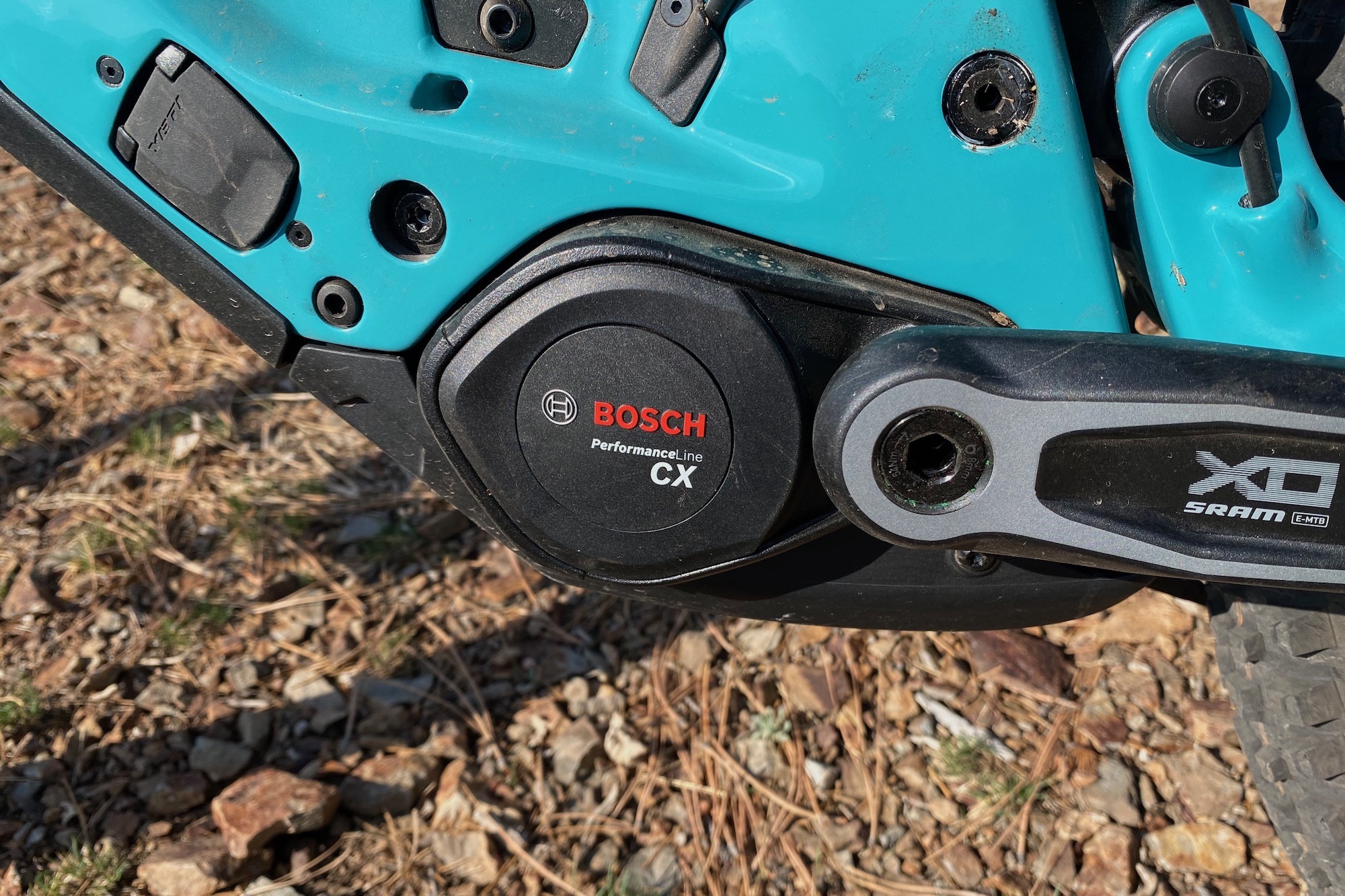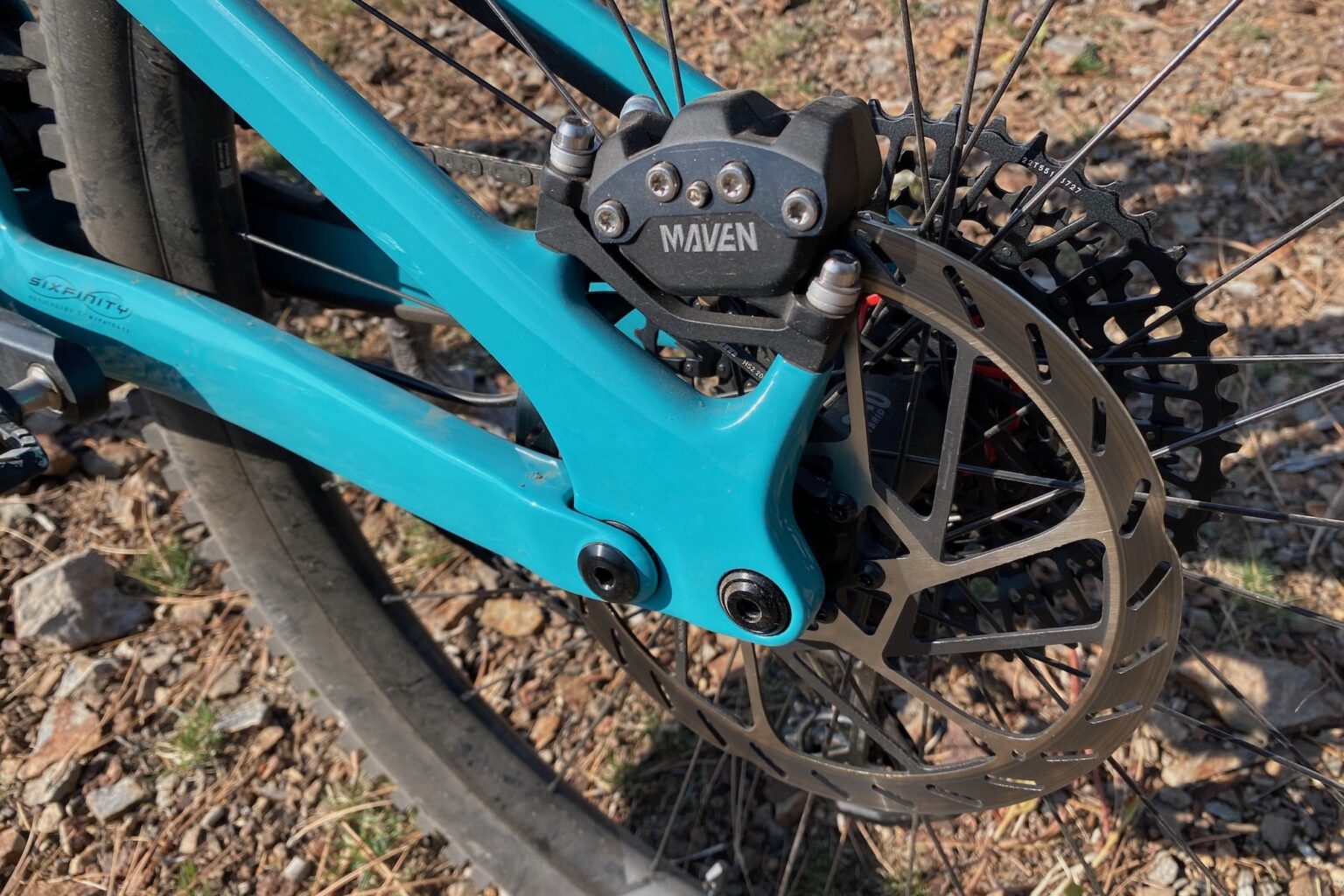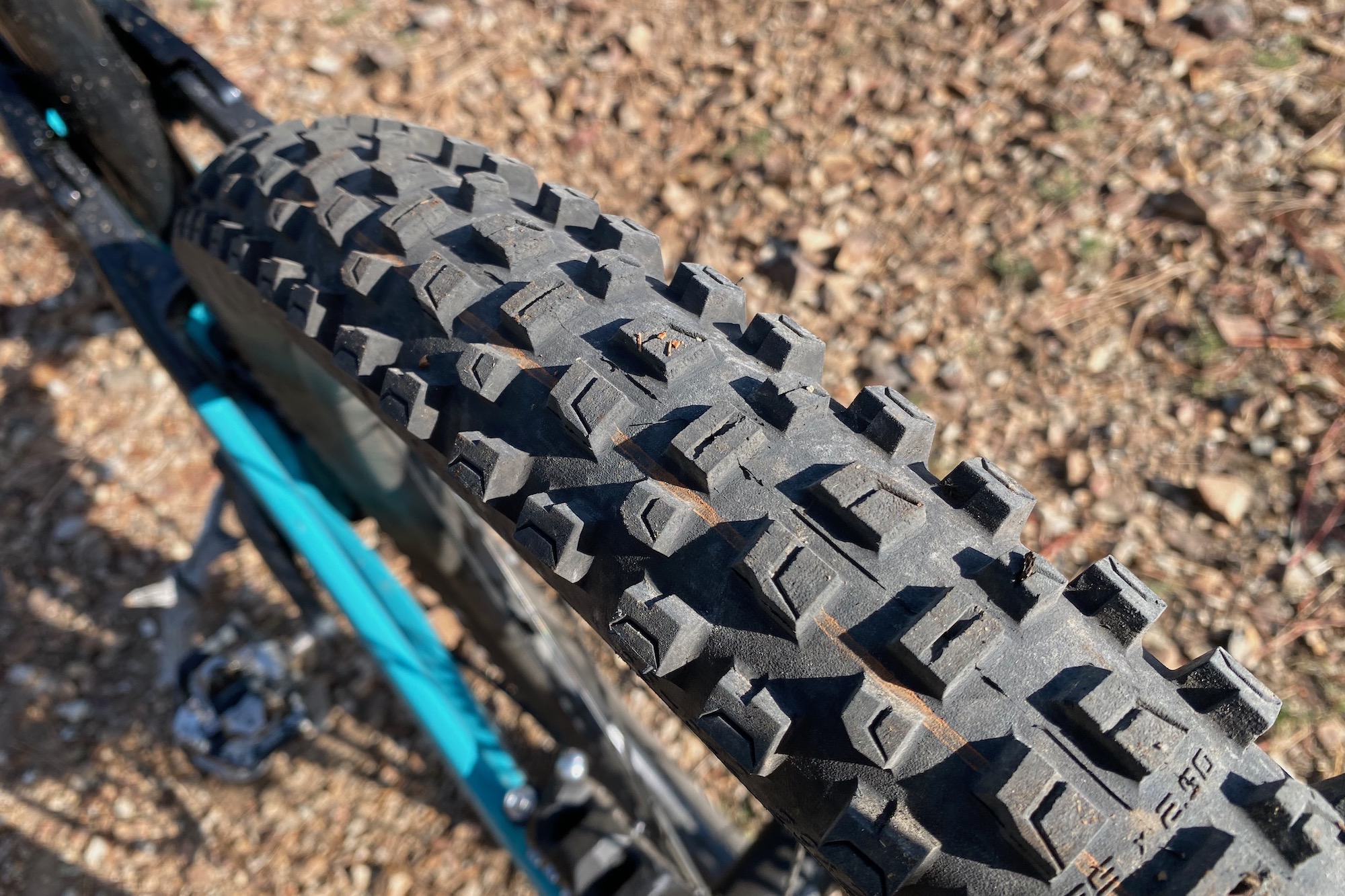The new Yeti LTe takes the 160e’s race-winning performance and brings it up to date with refreshed geometry, the Bosch CX (or CX-R) drive system, and new complete builds. While this updated full-power eMTB may be launching today, I was lucky enough to get my hands on a pre-launch test bike several weeks ago. If you’re interested in diving into the details, you can learn more in our Yeti LTe launch article that posted earlier today.
When I got the LTe, I was sidelined for a bit with a broken rib, but in the past couple of weeks, I’ve been able to put some proper miles and vertical on it to see how it performs. I’ve been sessioning some of the steepest, roughest, and longest descents — that I’m willing to ride, anyway — in the Reno/Tahoe area. With its updated geometry, the high-performing Bosch CX drive system, and the T3 XO build, this is easily one of the most capable, confidence-inspiring, and fun eMTBs I’ve ridden recently, and possibly ever.

Yeti LTe T3 XO Transmission Build
The folks at Yeti were kind enough to send me the LTe with the mid-range T3 XO Transmission build. This build is super nice and already plenty expensive at $12,900. I couldn’t possibly afford this bike, and I can’t really understand why anyone would pay $2K more for the T4 XX build ($14,900) — other than to look cool with the Podium inverted fork and XX drivetrain bits. Kudos to you if that’s your thing.
Still, with the T3, you can keep $2,000 in your bank account, and you’re still getting a Fox 38 Factory fork, Fox X2 Factory shock, Maven Silver brakes, DT Swiss HXC1700 carbon wheels, and SRAM XO Transmission drivetrain. The rest of the kit is dialed, too, with the Reverb AXS wireless dropper (200 mm on my large test frame), a comfy WTB Solano saddle, a Yeti Carbon Riser handlebar, and a set of Schwalbe Radial tires. This build really leaves nothing to be desired, for me anyway.
My size large test bike weighed in at 51.8 pounds. That’s not light, but respectable for having a full-power motor, 800 Wh battery, and burly build. My primary, or only, I guess, complaint about the LTe frame/build is that small rocks keep working their way into the downtube/battery cover and rattling around inside. They are easy enough to remove, but annoying nonetheless.

Yeti LTe Ride Impressions
This year, I’ve been pretty lucky to get to test a wide range of bikes. Among those, eMTBs are the least numerous by far, with just the Specialized S-Works Turbo Levo 4, the Norco Range VLT, and now, the Yeti LTe on my list. Still, that’s a pretty good spread of bike brands and styles, with the LTe landing almost squarely in between the Levo and the Norco in terms of suspension travel and intended use.
I’m not the rowdiest rider around, but I’m pretty capable and enjoy testing my limits on steep, aggressive trails when I’ve got the right bike for the task. Turns out, that’s exactly what Yeti made the LTe for, so off I went to rip laps on some of the more challenging climbs and descents in my area.

Climbing
The LTe is clearly a descent-focused bike, but like any good modern eMTB, it climbs like a bat out of hell if you want it to. Obviously, the motor system is a huge factor, but Yeti did a fine job with the geometry and suspension so that it’s comfortable and capable of scrambling up those impossibly steep climbs that are only possible on an e-bike.
First, the LTe’s updated geometry is a great fit for me. The 485 mm reach on the large frame is spot on for my lanky arms, and when paired with the 78-degree effective seat tube angle, increased stack, and Yeti Carbon Riser handlebar, it puts me in a very comfortable climbing position. From mellow trail approaches to properly steep you-can-only-make-that-in-turbo pitches, I’ve yet to find a situation that feels out of place. The WTB Solano saddle is among my favorites, too.

Second, the LTe is a big bike with relatively slack geometry, but it’s not totally unwieldy. Sure, it’s best at blasting up steep fire roads with reckless abandon and a head of steam, but I was pleasantly surprised by its maneuverability. The long and slack nature of the bike doesn’t scream agility, but I’ve been able to negotiate some seriously sharp switchbacks and very technical pitches far better than expected. The pedal-assist power plays a role, of course, and the Bosch system delivers with measured power output that helps you maintain traction and control. Sixifinity deserves a nod here as well, as its tuned anti-squat is supportive and calm under pedaling power without feeling harsh.
Third, the Bosch CX drive system is awesome. It might have a little bit less torque than the latest S-Works 3.1 or the DJI Avinox motors, but it’s still plenty powerful. With four levels of customizable pedal assist, everyone should be able to dial it in to their exact preferences. Tuning the motor through the Bosch Flow app isn’t quite as easy as Specialized’s app, but it’s still pretty dang easy. On my second ride, I perfected the LTe’s motor tune for my needs, and haven’t needed or wanted to touch it since.
Descending


This bike was specifically designed to go downhill fast, and it does that incredibly well. The combination of dialed geometry, ample travel, and a high-performing build makes this one of the most fun descending bikes I’ve ridden in recent memory. My wife has quickly grown tired of hearing me say how stoked I am when I get back from test rides, but I’ve got to tell someone, right?
The LTe’s 160/170 mm of rear/front travel is pretty much perfect for smashing rough, technical trails at speed, yet the bike retains some personality. There’s plenty of travel for soaking up bigger hits and drops, especially once you’ve gotten used to how composed and calm it is at speed. At the same time, it’s not just a pure plow machine, and I’m surprised by how maneuverable and poppy it feels when I want it to. I think much of that is related to the Sixfinity design. I’ve been using the middle/balanced progression setting, and it’s supportive in the mid stroke, composed deep in the travel, and I haven’t bottomed out yet. For comparison, the S-Works Levo felt a bit more agile and trail-oriented, while the Norco Range VLT felt more like a full-on DH bike with a motor.

The centered rider position and tall front end work well to keep excellent fore-aft balance and a commanding stance when things get steep. I’ve also found it easy and intuitive to keep the front wheel weighted to whip through tight, steep catch berms. However, I’m legitimately blown away by its stability at speed. When you really let this thing run, it’s like the world starts moving in slow motion. It’s honestly kind of hard to describe, but this bike just freaking rips.
Much of that comes down to the geometry, of course, which feels pretty perfect to me. But the well-considered component spec is also at play here. The Fox Factory suspension works great, and I was impressed with Yeti’s new shock calculator. It was still in beta for the LTe when I used it, but it got me very close to a perfect setup with just a few prompts. Fox’s X2 shock can be notoriously tricky to set up, but I started with Yeti’s suggested pressures and compression/rebound settings, then made some minor tweaks to dial it in to my preferences. It was a great baseline and helped get me close to perfect right out of the box, and in short order.

The burly DT Swiss HXC1700 wheels have a balanced ride feel and seem ready to take a proper beating. SRAM’s Maven brakes need no introduction and provide ample stopping power for the speeds you might find yourself carrying on the LTe. The cockpit is also well sorted with a 200 mm Reverb AXS dropper (length varies by frame size) and a 35 mm rise Yeti Carbon Riser handlebar. It’s hard for me to tell just how compliant that bar is, however, as the Schwalbe Magic Mary/Albert Gravity Radial tire combo seems to be doing plenty of work as well. Realistically, it’s those things combined with the cush suspension that give this bike its super muted and calm feel. And I mean that in the best way possible; it’s far from dull or lifeless on the trail, as long as those trails are rough, steep, and/or fast.
Range

I’ve yet to do a full battery drainer on the LTe, but I’ve been going out of my way to use more power and battery than I would if I were just going for “regular” rides. With work and other obligations, I’ve been trying to maximize my test riding and squeeze in as much vertical as possible in short periods of time. My test rides have all been in the hour-and-a-half-ish range with between 4,700 and 5,200 vertical feet of climbing/descending.
That’s to say, I have not been sipping on battery. Quite the contrary. I’ve been smashing climbs as fast as possible in eMTB+ mode (customized, of course) but with plenty of my own effort going into the pedals. When I’ve finished these ~5k vertical foot rides, I’ve had somewhere between 30 and 40% battery left each time. With more time, lower assist modes, and more pedaling effort, I’m sure I could easily hit the 8,000-foot mark, and that’s just using the 800 Wh internal battery.

Yeti LTe: More Than a Race Bike?
Yeti definitely bills the LTe — and the 160e before it — as an e-EWS race-ready bike. While I’m sure it’s well-designed for the task and it has already proven itself on the world stage, this isn’t just a niche race bike. This thing is an absolute ripper that’s a great option for anyone who frequents aggressive terrain and likes to push their limits. In my relatively limited experience, I’ve become a big fan, and I’ll probably never enter an e-enduro race.
But for as big a fan as I’ve become, I’ll also be quick to recognize the LTe isn’t the most versatile or a great fit for everyone, nor is it intended to be. If the words steep, rough, and fast are not in your regular trail or route descriptions, you might want to look elsewhere — perhaps even the mid-travel, mid-power Yeti MTe. But if they are, look no further, or at least look at the price tag.
Price is undoubtedly a major consideration, as Yeti bikes aren’t exactly synonymous with value, and numerous factors continue to drive prices in the bike industry ever higher. I won’t claim that Yeti’s LTe prices are budget-friendly, but they are strikingly similar to those of other high-end brands these days. Heck, the $20,000 Specialized S-Works Levo 4 LTD makes just about every other bike look affordable now…
Like most high-end bikes of any kind, if it suits your riding style and you’re willing and able to afford it, I highly doubt you’ll be disappointed by the new LTe. I’m certainly not. I just hope they’ll let me keep riding it for a little bit longer.
